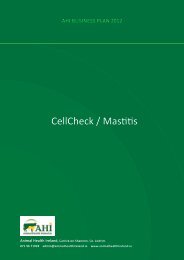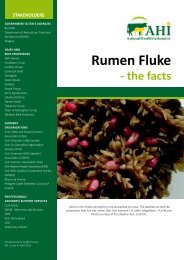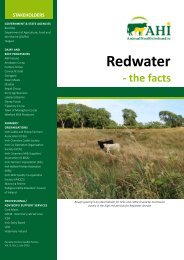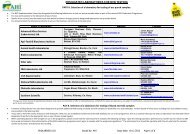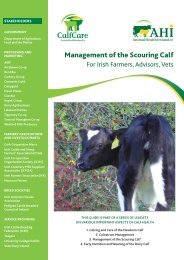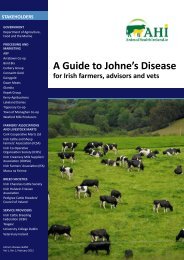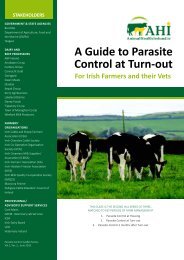Rumen Fluke - Animal Health Ireland
Rumen Fluke - Animal Health Ireland
Rumen Fluke - Animal Health Ireland
Create successful ePaper yourself
Turn your PDF publications into a flip-book with our unique Google optimized e-Paper software.
STAKEHOLDERS<br />
GOVERNMENT<br />
Department of Agriculture,<br />
Fisheries and Food<br />
PROCESSING AND<br />
MARKETING<br />
AIBP<br />
An Bord Bia<br />
Arrabawn<br />
Carbery Group<br />
Connacht Gold<br />
Dairygold<br />
Dawn Meats<br />
Glanbia<br />
Kepak Group<br />
Kerry Group<br />
Lakeland Dairies<br />
FARMERS’ ASSOCIATIONS<br />
AND LIVESTOCK MARTS<br />
Cork Cooperative Marts Ltd.<br />
Irish Cattle and Sheep<br />
Farmers’ Association (ICSA)<br />
Irish Cooperative<br />
Organisation Society (ICOS)<br />
Irish Creamery Milk Suppliers’<br />
Association (ICMSA)<br />
Irish Farmers’ Association<br />
(IFA)<br />
Macra na Feirme<br />
BREED SOCIETIES<br />
Irish Holstein Friesian<br />
Association<br />
Pedigree Cattle Breeders’<br />
Council of <strong>Ireland</strong><br />
SERVICE PROVIDERS<br />
Irish Cattle Breeding<br />
Federation (ICBF)<br />
Teagasc<br />
University College Dublin<br />
Veterinary <strong>Ireland</strong><br />
<strong>Rumen</strong> <strong>Fluke</strong> – The Facts:<br />
For Irish Farmers and their Vets<br />
Adult rumen flukes among the ruminal papillae of a cow. The papillae are leaf-like<br />
projections that line the rumen (the 'first stomach') of cattle. Magnified c. 4 x life size.<br />
Photo courtesy of Pat Sheehan SLA, Cork RVL.
2<br />
THIS GUIDE WILL HELP YOU AND YOUR VET DEVELOP A CONTROL PROGRAMME<br />
FOR RUMEN FLUKE ON YOUR FARM<br />
Introduction<br />
<strong>Rumen</strong> flukes occur worldwide and have been associated with significant disease (paramphistomosis) in tropical<br />
and sub-tropical countries. In recent years, the prevalence of rumen flukes in <strong>Ireland</strong> has increased. It is likely<br />
that small numbers of parasites cause little or no damage. The effect of low burdens on long-term productivity<br />
remains to be evaluated by scientific research. However, the significance of this parasite seems to be directly<br />
related to the number of immature rumen flukes present in the small intestine. The degree of infection varies<br />
with farm and year and is related to factors such as the weather and ground conditions (flooding) which will<br />
affect its life cycle. There have been a small number of reports of this parasite causing serious disease and<br />
production loss on farms where heavy burdens of larval flukes were taken in by grazing cattle or sheep over a<br />
short period of time. These circumstances lead to heavy burdens of larval rumen flukes in the intestine, and a<br />
severe damage to the lining of the intestine (enteritis).<br />
Larval flukes form<br />
cysts on grass<br />
(metacercariae)<br />
Metacercarial cyst wall is digested in<br />
duodenum (first part of small intestine),<br />
releasing larval fluke<br />
The larval stage of the rumen fluke<br />
attaches to the wall of the upper small<br />
intestine (duodenum) and feeds on plugs<br />
bitten from the wall, causing severe fluid and<br />
blood loss if large numbers are present.<br />
Both cattle and sheep are equally susceptible to infestation<br />
Immature (larval) flukes develop through several stages<br />
in aquatic snails (e.g. Planorbis planorbis, the ram's horn snail)<br />
Life Cycle of the <strong>Rumen</strong> <strong>Fluke</strong> Paramphistomum<br />
Larvae migrate to the<br />
first stomach (rumen)<br />
Adult rumen<br />
flukes lay eggs<br />
<strong>Rumen</strong> fluke eggs are passed out<br />
onto the pasture in faeces<br />
A range of aquatic snails<br />
can act as intermediate hosts.<br />
This is Planorbis corneus
3<br />
WHAT ARE THE SIGNS THAT RUMEN FLUKE MAY BE A<br />
PROBLEM IN YOUR HERD?<br />
Clinical disease is RARE, but a small number of severe cases have been reported with the following<br />
clinical signs:<br />
• dullness<br />
• dehydration<br />
• rapid weight loss<br />
• severe watery scour, which may contain traces of blood<br />
• anaemia<br />
• low blood protein concentrations<br />
• swelling under the jaw, known as bottle-jaw, or in Irish ‘pocán’<br />
Left untreated, severely affected animals may die due to dehydration.<br />
The clinical signs described above are not exclusive to<br />
rumen flukes and diagnosis by clinical signs alone is<br />
unreliable. However, certain features of the disease such<br />
as severe scour and weight loss, abnormally low levels<br />
of albumin (a blood protein) in blood samples combined<br />
with a knowledge of previous grazing history (pasture<br />
type) would raise suspicions.<br />
Laboratory testing will readily detect eggs in the faeces<br />
of an animal carrying adult rumen flukes. The eggs<br />
superficially resemble those of liver fluke, but laboratory<br />
analysts can readily differentiate between them. It is<br />
much more difficult to confirm disease caused by the<br />
immature flukes (larval paramphistomosis), as there are<br />
no conclusive findings in faeces or blood samples. To<br />
detect rumen fluke eggs, the laboratory will require<br />
<strong>Rumen</strong> fluke egg.<br />
Photo courtesy of Jim O'Donovan RO, Athlone RVL.<br />
approximately 20 grams of faeces (a dessertspoonful), packed in a watertight, clean, non-breakable container,<br />
and marked with the animal's tag number or other identification. Blood samples are required to test for blood<br />
proteins.<br />
Even if disease caused by immature flukes is suspected, it is worth checking a faecal sample for eggs. <strong>Animal</strong>s<br />
grazing on pasture that is heavily contaminated with rumen fluke larval cysts will usually have all ages of<br />
rumen flukes in their digestive tracts, and thus have an egg count. In very severe cases observed by the Irish<br />
Regional Veterinary Laboratories, large numbers of immature rumen flukes have been found in the faeces.<br />
Post mortem examination of animals (very shortly after death) with a history of the clinical signs described<br />
above is a very reliable confirmatory technique.<br />
CONTACT YOUR LOCAL VET TO PLAN YOUR RUMEN FLUKE<br />
INVESTIGATION AND CONTROL PROGRAMME
4<br />
WHY DO ONLY A MINORITY OF CATTLE OR FARMS DEVELOP<br />
DISEASE DUE TO RUMEN FLUKE?<br />
Cattle appear to be more susceptible to rumen fluke infection if they are young, sick or poorly nourished.<br />
However, if there are very large numbers of infective larvae on pasture such as in heavily grazed areas that<br />
flood in winter, all cattle are susceptible to some degree.<br />
Grazing on waterlogged pastures and areas prone to flooding are also significant risk factors, especially in a wet<br />
summer.<br />
Traditionally, the rumen fluke was not considered to be a significant parasite of Irish cattle, mainly because it<br />
was only seen in very low numbers, and was not associated with clinical disease. In recent years a number of<br />
very severe outbreaks, with multiple fatalities, have focused attention on the rumen fluke. The characteristic<br />
eggs have been increasingly detected in faecal samples in the same period, but it seems likely that this is due<br />
in part to increased monitoring and awareness of the parasite.
5<br />
HOW CAN I CONTROL RUMEN FLUKE IN MY HERD?<br />
1<br />
2<br />
3<br />
BIOSECURITY<br />
Prevent introduction of rumen flukes onto your farm.<br />
Bought-in animals of unknown origin or animals that are from known rumen fluke-infested farms should be<br />
tested by faecal examination and dosed with an effective product prior to allowing access to pasture, if they<br />
have rumen fluke eggs in their faeces.<br />
REDUCE EXPOSURE<br />
Reduce the possibility of exposure to rumen fluke larvae on pasture.<br />
Restricting access to fields, or parts of fields, which are prone to flooding or water-logging will reduce<br />
exposure to contaminated herbage. The fencing-off of drains, ponds and watercourses should also reduce<br />
exposure. These measures also have the added benefit of reducing exposure to liver fluke.<br />
TREATMENT<br />
Flukicidal drugs.<br />
MOST DRUGS THAT KILL LIVER FLUKES DO NOT KILL RUMEN FLUKES<br />
Most of the drugs that control liver fluke DO NOT kill rumen flukes. At the time of writing (autumn 2010),<br />
oxyclozanide is the only medicinal ingredient on the Irish market that kills both mature and immature rumen<br />
flukes. Oxyclozanide is marketed in a number of different formulations, either as a sole ingredient or<br />
combined with a wormer. While oxyclozanide is not very effective against immature liver flukes, it will kill<br />
immature rumen flukes.<br />
Planorbis corneus snail, which can be used as an intermediate host by larval rumen fluke.<br />
Photo courtesy of Dr. Bob Hanna, AFBINI, Stormont.
6<br />
HOW DO I KNOW IF MY CONTROL PROGRAMME IS WORKING?<br />
It is important to remember that the detection of rumen fluke eggs in faecal samples or the detection of the<br />
adults in small numbers in the rumen is not in itself a reason to institute specific control measures, as light<br />
infections appear to have no effect on animal health or productivity. The routine implementation of a preventive<br />
dosing regime for rumen flukes is rarely justified, except on farms where severe disease and losses have been<br />
confirmed in the past. Because of the rarity of severe outbreaks, such a control scheme would be best designed<br />
and tailored for the specific farm in question, following consultation with your veterinary practitioner / advisor.<br />
Such a scheme would aim to use treatment in a strategic manner to reduce pasture contamination, in<br />
association with other measures mentioned above.<br />
Apart from the economic costs that arise from unnecessary use of any anti-parasitic drug, it is especially<br />
important to treat rumen flukes sensibly and sparingly, given that there is only one effective compound<br />
(oxyclozanide). The development of oxyclozanide-resistant strains of rumen fluke must be avoided at all costs.<br />
The development of such strains is a distinct possibility if a single compound like oxyclozanide is used<br />
indiscriminately over several years.<br />
<strong>Rumen</strong> <strong>Fluke</strong> Version 2, August 2011<br />
DO NOT TREAT RUMEN FLUKE UNLESS CLINICAL SIGNS ARE PRESENT<br />
TECHNICAL WORKING GROUP: Michael Doherty (Chairman): UCD School of Agriculture, Food Science and Veterinary Medicine. Donal Toolan: Regional Veterinary Laboratory, Kilkenny.<br />
Barbara Good: Teagasc, Athenry. Michéal Casey: Regional Veterinary Laboratory, Backweston. Dr. Theo de Waal – UCD, School of Agriculture, Food Science and Veterinary Medicine. Maura Langan:<br />
Norbrook Ltd. Fintan Graham: Veterinary <strong>Ireland</strong>. Grace Mulcahy: UCD School of Agriculture, Food Science and Veterinary Medicine. Martin Danaher: Teagasc Food Research Centre, Ashtown. Regina<br />
Sayers: Teagasc, Moorepark. Bosco Cowley: Intervet Schering-Plough.<br />
Ian Hogan: Regional Veterinary Laboratory, Limerick. Tom Murphy: Central Veterinary Research Laboratory, Backweston. Andy Forbes: Merial, Lyons, France.<br />
GROUP RAPPORTEUR: Mary Canty: Centre for Veterinary Epidemiology and Risk Analysis, UCD.<br />
PEER REVIEW BY: Dr. Eric Morgan: University of Bristol. Prof. Bob Hanna: Agri-Food and Biosciences Institute, Belfast.<br />
<strong>Animal</strong> <strong>Health</strong> <strong>Ireland</strong>, Main Street, Carrick-on-Shannon, Co. Leitrim 071 9671928 www.animalhealthireland.ie email: admin@animalhealthireland.ie<br />
IMPORTANT NOTICE — DISCLAIMER<br />
While every reasonable effort has been made to ensure the accuracy of the contents of this leaflet at the time of printing, no representation or guarantee is given, whether by AHI, its employees,<br />
subcontractors, agents, distributors or any other person, that the contents of this information leaflet are comprehensive, up to date, or free from error or omissions, nor that the advice provided is<br />
appropriate in every particular circumstance.<br />
The contents of this information leaflet are not intended to be a substitute for appropriate direct advice from a veterinarian. Appropriate veterinary advice should be taken before taking or refraining from<br />
taking action in relation to the animal disease dealt within this information leaflet.



